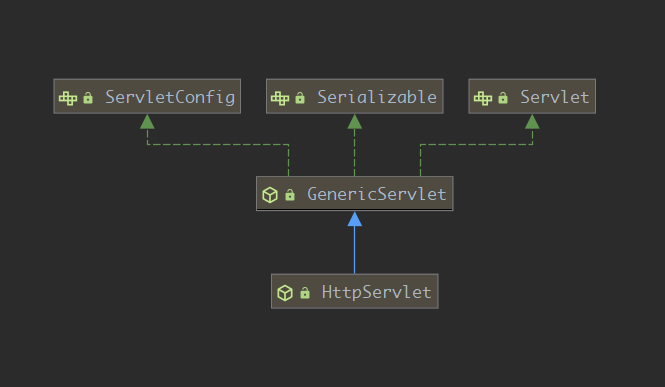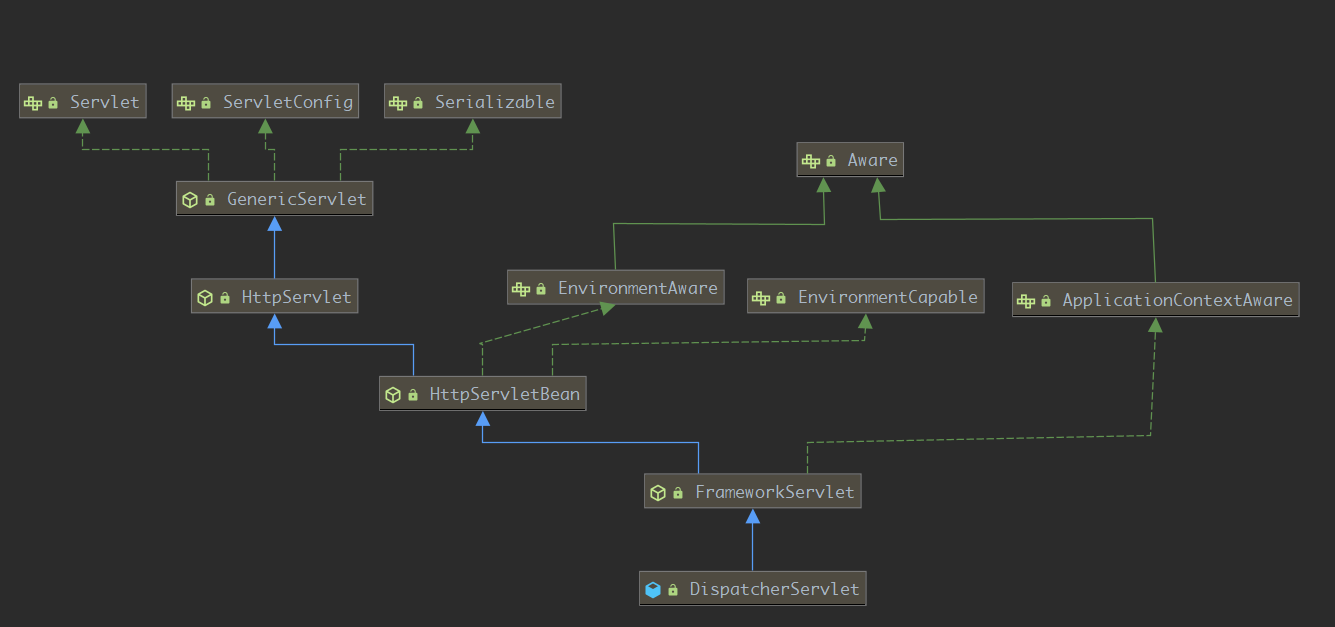SpringMVC探秘-请求之路
SpringMVC探秘-请求之路
开始
今天来分析一下SpringMVC的原理,探究SpringMVC如何把请求传递到每个Controller的方法上,从Servlet到Controller,一个请求走了哪些艰难曲折的路。
基本核心组件
在开始分析之前,先了解SpringMVC中的几个概念,后面提到的时候不至于不知道这个是干什么用的,不过不用彻底知道这个组件是如何实现的,现在只需要知道有这个东西就行了, 先混个脸熟
| 组件 | 说明 |
|---|---|
| DispatcherServlet | SpringMVC中的中心,处理请求的分发,视图的解析等,本质上是一个Servlet |
| HandlerMapping | 一个映射,<URL,Handler>,可以根据URL找到匹配的Handler,这儿的Handler是HandlerExecutionChain |
| HandlerAdapter | Hander的适配器,委托这个适配器去调用具体的某个Hander |
| ViewResolver | 视图解析器,用于将视图名称解析为视图对象 View。 |
这些组件都是经过DispatcherServlet的协调,把一个请求分发到具体的一个Hander,然后根据Hander的返回值,来做不同的处理,不同的组件处理不同的逻辑。
追根溯源
请求的入口-Servlet
我们都知道Servlet是一个标准,我们的处理逻辑代码只需要写到Servlet中,而对于Http请求响应的解析处理都不需要我们关心,已经有很多服务器实现了这部分,比如熟悉的小猫猫Tomcat,它就是按照Servlet的标准来实现的。

ServletConfig
/**
* A servlet configuration object used by a servlet container to pass
* information to a servlet during initialization.
* 当servlet实例化的时候,servlet容器传递给servlet的配置
*/
public interface ServletConfig {
/**
* Returns the name of this servlet instance. The name may be provided via
* server administration, assigned in the web application deployment
* descriptor, or for an unregistered (and thus unnamed) servlet instance it
* will be the servlet's class name.
* 返回servlet的名字,如果没有指定,则返回servlet的类名
* @return the name of the servlet instance
*/
public String getServletName();
/**
* Returns a reference to the {@link ServletContext} in which the caller is
* executing.
* 返回调用者当前执行环境的ServletContext引用
* @return a {@link ServletContext} object, used by the caller to interact
* with its servlet container
* @see ServletContext
*/
public ServletContext getServletContext();
/**
* Returns a <code>String</code> containing the value of the named
* initialization parameter, or <code>null</code> if the parameter does not
* exist.
* 返回一个字符串类型的值,这个值是初始化的参数
* @param name
* a <code>String</code> specifying the name of the
* initialization parameter
* @return a <code>String</code> containing the value of the initialization
* parameter
*/
public String getInitParameter(String name);
/**
* Returns the names of the servlet's initialization parameters as an
* <code>Enumeration</code> of <code>String</code> objects, or an empty
* <code>Enumeration</code> if the servlet has no initialization parameters.
* 返回所有的初始化参数
* @return an <code>Enumeration</code> of <code>String</code> objects
* containing the names of the servlet's initialization parameters
*/
public Enumeration<String> getInitParameterNames();
}
Servlet
package javax.servlet;
import java.io.IOException;
/**
* 所有的servlet都应该实现这里的方法
*
* servlet是一个运行在Web Server的小Java程序,它们接受对来自web客户端的请求并做出响应,这些请求通常通过HTTP传达
*
* 为了实现这个接口,你可以写一个基于javax.servlet.GenericServlet,或者HTTP Servletjavax.servlet.http.HttpServlet派生的servlet类
*
* 这个接口定义了实例化servlet,接受请求,从server移除的方法,这些方法被称为生命周期方法:并且按照一些的顺序调用:
* 1. servlet被实例化,调用init()方法初始化
* 2. 当有来自客户端的调用,serviceI()方法被调用
* 3. servlet退出服务,destory()方法被调用,然后执行GC
*
* 除了生命周期方法外,这个接口还提供了getServletConfig方法来获取启动信息,getServletInfo来获取
* servlet自身的基本信息,比如作者,版本,版权等
*
* @see GenericServlet
* @see javax.servlet.http.HttpServlet
*/
public interface Servlet {
/**
* 被servlet容器调用,表示这个servlet将要开始服务
*
* servlet实例化之后马上调用这个方法,在开始处理请求前这个方法必须调用成功
*
* 如果这个方法抛出异常或者在指定的时间段没有返回,那么这个serlet也不能处理请求
* @exception ServletException
* if an exception has occurred that interferes with the
* servlet's normal operation
*
* @see UnavailableException
* @see #getServletConfig
*/
public void init(ServletConfig config) throws ServletException;
/**
* 获取ServletConfig,存储了启动参数
* @return the <code>ServletConfig</code> object that initializes this
* servlet
*
* @see #init
*/
public ServletConfig getServletConfig();
/**
* 被Servlet容器调用,用来对一个请求做出响应
*
* 只有当servlet中的init()方法调用成功后这个方法才会调用
*
* 应该为抛出异常或者错误的servlet返回的response设置响应码
*
* 这个方法可能被并发调用,所以开发者对于共享的资源要同步操作,共享的资源比如,文件,网络连接,
* 还有servlet的类变量和实例变量
* @param req
* the <code>ServletRequest</code> object that contains the
* client's request
*
* @param res
* the <code>ServletResponse</code> object that contains the
* servlet's response
*
* @exception ServletException
* if an exception occurs that interferes with the servlet's
* normal operation
*
* @exception IOException
* if an input or output exception occurs
*/
public void service(ServletRequest req, ServletResponse res)
throws ServletException, IOException;
/**
* 获取Servlet基本信息
*
* @return a <code>String</code> containing servlet information
*/
public String getServletInfo();
/**
* 这个方法被调用,表明这个servlet已经不再处理请求,这个方法在多线程环境也只调用一次,调用后,
* service方法将不会再调用
*
* 给一个servlet释放资源的机会,比如文件,还有需要持久化的资源需和内存中的状态同步
*/
public void destroy();
}
GenericServlet
GenericServlet 实现了 Servlet 和 ServletConfig 两个接口,为这两个接口中的部分方法提供了简单的实现。比如该类实现了 Servlet 接口中的 void init(ServletConfig) 方法,并在方法体内调用了内部提供了一个无参的 init 方法,子类可覆盖该无参 init 方法。除此之外,GenericServlet 还实现了 ServletConfig 接口中的 getInitParameter 方法,用户可直接调用该方法获取到配置信息。而不用先获取 ServletConfig,然后再调用 ServletConfig 的 getInitParameter 方法获取
GenericServlet 是一个协议无关的 servlet,是一个比较原始的实现,通常我们不会直接继承该类。一般情况下,我们都是继承 GenericServlet 的子类 HttpServlet,该类是一个和 HTTP 协议相关的 Servlet。那下面我们来看一下这个类
HttpServlet
HttpServlet,从名字上就可看出,这个类是和 HTTP 协议相关。该类的关注点在于怎么处理 HTTP 请求,比如其定义了 doGet 方法处理 GET 类型的请求,定义了 doPost 方法处理 POST 类型的请求等。我们若需要基于 Servlet 写 Web 应用,应继承该类,并覆盖指定的方法。doGet 和 doPost 等方法并不是处理的入口方法,所以这些方法需要由其他方法调用才行。其他方法是哪个方法呢?对,在Servlet接口定义处理请求的方法service中。当然在HttpServlet中还有一些处理缓存的逻辑
请求分发中央-DispatcherServlt
在认识它之前,介绍一下它在家族中的地位

对于Servlet相关的类和接口上面已经介绍过了,这里多了一些以Aware结尾的接口,是Spring IOC中的接口,
HttpServletBean
重写了GenericServlet中的init()方法,设置servlet配置的初始化参数
FrameworkServlet
FrameworkServlet 是 Spring Web 框架中的一个基础类,该类会在初始化时创建一个容器。同时该类覆写了 doGet、doPost 等方法,并将所有类型的请求委托给 doService 方法去处理。doService 是一个抽象方法,需要子类实现。
servlet被实例化后,会调用GenericServlet的init(ServletConfig config)方法,然后会无参init()方法,HttpServletBean重写了init()方法,这个方法会调用交给子类去实现的initServletBean()方法,现在就到了FrameworkServlet中的initServletBean(),该方法会调用initWebApplicationContext(),这里创建多个容器我,他们之间的关系后面我们再说
DispatcherServlet
DispatcherServlet就是核心的一个组件,来负责协调各个组件,同事初始化这些组件如,HanderMapping,HanderAdapter等。
中央处理器DispatcherServlet
我们继续从上面的FrameworkServlet调用的doService方法入手
/**
* Exposes the DispatcherServlet-specific request attributes and delegates to {@link #doDispatch}
* for the actual dispatching.
*/
@Override
protected void doService(HttpServletRequest request, HttpServletResponse response) throws Exception {
logRequest(request);
// Keep a snapshot of the request attributes in case of an include,
// to be able to restore the original attributes after the include.
Map<String, Object> attributesSnapshot = null;
if (WebUtils.isIncludeRequest(request)) {
attributesSnapshot = new HashMap<>();
Enumeration<?> attrNames = request.getAttributeNames();
while (attrNames.hasMoreElements()) {
String attrName = (String) attrNames.nextElement();
if (this.cleanupAfterInclude || attrName.startsWith(DEFAULT_STRATEGIES_PREFIX)) {
attributesSnapshot.put(attrName, request.getAttribute(attrName));
}
}
}
// Make framework objects available to handlers and view objects.
request.setAttribute(WEB_APPLICATION_CONTEXT_ATTRIBUTE, getWebApplicationContext());
request.setAttribute(LOCALE_RESOLVER_ATTRIBUTE, this.localeResolver);
request.setAttribute(THEME_RESOLVER_ATTRIBUTE, this.themeResolver);
request.setAttribute(THEME_SOURCE_ATTRIBUTE, getThemeSource());
if (this.flashMapManager != null) {
FlashMap inputFlashMap = this.flashMapManager.retrieveAndUpdate(request, response);
if (inputFlashMap != null) {
request.setAttribute(INPUT_FLASH_MAP_ATTRIBUTE, Collections.unmodifiableMap(inputFlashMap));
}
request.setAttribute(OUTPUT_FLASH_MAP_ATTRIBUTE, new FlashMap());
request.setAttribute(FLASH_MAP_MANAGER_ATTRIBUTE, this.flashMapManager);
}
try {
// 处理请求
doDispatch(request, response);
}
finally {
if (!WebAsyncUtils.getAsyncManager(request).isConcurrentHandlingStarted()) {
// Restore the original attribute snapshot, in case of an include.
if (attributesSnapshot != null) {
restoreAttributesAfterInclude(request, attributesSnapshot);
}
}
}
}
doService中就是给request设置一些参数,然后调用doDispatch()方法。doDispatch()才是真正处理请求的方法
protected void doDispatch(HttpServletRequest request, HttpServletResponse response) throws Exception {
HttpServletRequest processedRequest = request;
// 这个对象包含HnadlerInterceptor集合和Handler对象
HandlerExecutionChain mappedHandler = null;
boolean multipartRequestParsed = false;
WebAsyncManager asyncManager = WebAsyncUtils.getAsyncManager(request);
try {
ModelAndView mv = null;
Exception dispatchException = null;
try {
// 检查是否是Multipart request,如果是并且有MultipartResolver,则返回MultipartResolver处理后的request
processedRequest = checkMultipart(request);
// 是否被MultipartResolver处理
multipartRequestParsed = (processedRequest != request);
// Determine handler for the current request.
// 从HanderMapping获取HandlerExecutionChain
mappedHandler = getHandler(processedRequest);
if (mappedHandler == null) {
noHandlerFound(processedRequest, response);
return;
}
// Determine handler adapter for the current request.
// 获取可执行处理器逻辑的适配器 HandlerAdapter
HandlerAdapter ha = getHandlerAdapter(mappedHandler.getHandler());
// Process last-modified header, if supported by the handler.
// HTTP缓存相关
String method = request.getMethod();
boolean isGet = "GET".equals(method);
if (isGet || "HEAD".equals(method)) {
long lastModified = ha.getLastModified(request, mappedHandler.getHandler());
if (new ServletWebRequest(request, response).checkNotModified(lastModified) && isGet) {
return;
}
}
// 执行拦截器 preHandle 方法
if (!mappedHandler.applyPreHandle(processedRequest, response)) {
return;
}
// 调用处理器逻辑,对应步骤
mv = ha.handle(processedRequest, response, mappedHandler.getHandler());
if (asyncManager.isConcurrentHandlingStarted()) {
return;
}
// 如果 controller 未返回 view 名称,这里生成默认的 view 名称
applyDefaultViewName(processedRequest, mv);
// 执行拦截器 postHandle 方法
mappedHandler.applyPostHandle(processedRequest, response, mv);
}
catch (Exception ex) {
dispatchException = ex;
}
catch (Throwable err) {
// As of 4.3, we're processing Errors thrown from handler methods as well,
// making them available for @ExceptionHandler methods and other scenarios.
dispatchException = new NestedServletException("Handler dispatch failed", err);
}
// 解析并渲染视图
processDispatchResult(processedRequest, response, mappedHandler, mv, dispatchException);
}
catch (Exception ex) {
triggerAfterCompletion(processedRequest, response, mappedHandler, ex);
}
catch (Throwable err) {
triggerAfterCompletion(processedRequest, response, mappedHandler,
new NestedServletException("Handler processing failed", err));
}
finally {
if (asyncManager.isConcurrentHandlingStarted()) {
// Instead of postHandle and afterCompletion
if (mappedHandler != null) {
mappedHandler.applyAfterConcurrentHandlingStarted(processedRequest, response);
}
}
else {
// Clean up any resources used by a multipart request.
if (multipartRequestParsed) {
cleanupMultipart(processedRequest);
}
}
}
}
getHander(HttpServletRequest)
/**
* 遍历所有的HanderMapping,获取一个HanderExecutionChian
* Return the HandlerExecutionChain for this request.
* <p>Tries all handler mappings in order.
* @param request current HTTP request
* @return the HandlerExecutionChain, or {@code null} if no handler could be found
*/
@Nullable
protected HandlerExecutionChain getHandler(HttpServletRequest request) throws Exception {
if (this.handlerMappings != null) {
for (HandlerMapping mapping : this.handlerMappings) {
HandlerExecutionChain handler = mapping.getHandler(request);
if (handler != null) {
return handler;
}
}
}
return null;
}
getHandlerAdapter
/**
* Return the HandlerAdapter for this handler object.
* @param handler the handler object to find an adapter for
* @throws ServletException if no HandlerAdapter can be found for the handler. This is a fatal error.
*/
protected HandlerAdapter getHandlerAdapter(Object handler) throws ServletException {
if (this.handlerAdapters != null) {
for (HandlerAdapter adapter : this.handlerAdapters) {
if (adapter.supports(handler)) {
return adapter;
}
}
}
throw new ServletException("No adapter for handler [" + handler +
"]: The DispatcherServlet configuration needs to include a HandlerAdapter that supports this handler");
}
processDispatchResult
/**
* Handle the result of handler selection and handler invocation, which is
* either a ModelAndView or an Exception to be resolved to a ModelAndView.
*/
private void processDispatchResult(HttpServletRequest request, HttpServletResponse response,
@Nullable HandlerExecutionChain mappedHandler, @Nullable ModelAndView mv,
@Nullable Exception exception) throws Exception {
boolean errorView = false;
if (exception != null) {
if (exception instanceof ModelAndViewDefiningException) {
logger.debug("ModelAndViewDefiningException encountered", exception);
mv = ((ModelAndViewDefiningException) exception).getModelAndView();
}
else {
Object handler = (mappedHandler != null ? mappedHandler.getHandler() : null);
mv = processHandlerException(request, response, handler, exception);
errorView = (mv != null);
}
}
// Did the handler return a view to render?
if (mv != null && !mv.wasCleared()) {
render(mv, request, response);
if (errorView) {
WebUtils.clearErrorRequestAttributes(request);
}
}
else {
if (logger.isTraceEnabled()) {
logger.trace("No view rendering, null ModelAndView returned.");
}
}
if (WebAsyncUtils.getAsyncManager(request).isConcurrentHandlingStarted()) {
// Concurrent handling started during a forward
return;
}
if (mappedHandler != null) {
mappedHandler.triggerAfterCompletion(request, response, null);
}
}
后记
整个请求的流程就走完了,但是对于HandlerMapping和HandlerAdapter,如何渲染视图这块没有详细说,因为现在我也还不太懂,等后面会再写文章来说明。
再DispatcherServlet初始化后,会创建容器和创建组件,这些在本文中也没有说明,篇幅限制就另外写一篇来做解释了。
最新文章
- 3-1 Linux文件管理类命令详解
- 【助教】Java获取数据库数据展示
- JS控制css float属性的用法经验总结
- 9. Palindrome Number
- 手机低端市场,联发科 vs 高通
- LeetCode Day4——Factorial Trailing Zeroes
- python 使用xrld
- Python对数据库的增删改查
- Android Studio 合并分支代码到主干的操作总结
- 大批量delete 优化方案
- 清除UIWebView缓存
- 简述Python入门小知识
- C# 编码标准(三)
- 收集的一些python基础教学博客
- 一次查找Windows Live Writer的VSPaste插件丢失RTF格式信息的经历
- linux 文件搜索命令find、-name、-iname、通配符*?、-size、-user、-group、-amin、-cmin、-mmin、-a、-o、-exec/-ok、-inum
- Hadoop学习之路(五)Hadoop集群搭建模式和各模式问题
- m2014-architecture-imgserver->配置lighttpd mod_mem_cache 模块做静态资源服务器
- css3 伪元素和伪类选择器详解
- MQTT的学习之Mosquitto安装&使用(1)